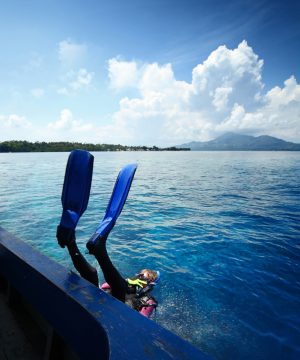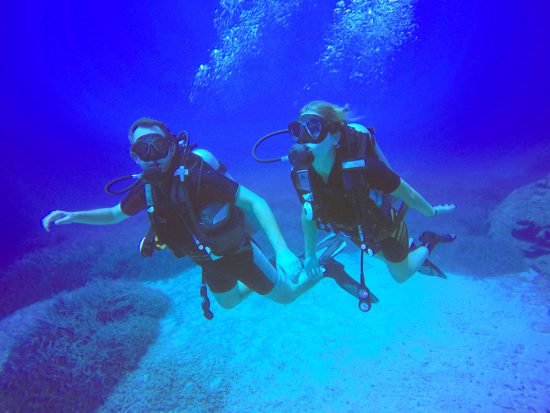What do you do when you’re faced with the challenge of getting underwater in a strong surface current? This happened to me some years ago and I had no idea of how to enter the water like this type of current.
The only thing I wanted to do was to get down under and see this ‘much talked about’ underwater pinnacle in Koh Bon out in the beautiful Similan Islands of Thailand. The story of a diver’s life right?
If you try to make a normal dive entrance into the water, you will only be swept away at the surface and have no time to make corrections like getting some extra lead. It will be impossible to even catch up to your dive buddy and dive group because they will already be below the water’s surface and diving straight down.
In this article, I have 9 great tips to help make your ‘negative;’ entry in strong surface currents easier and fun doing it from liveaboards, day boats, or small dive boats. These steps will help avoid missing your underwater target, in this particular case, the spectacular underwater Koh Bon pinnacle.
I also have a great video for you to watch and some incredible dive destinations I think you might be interested in.
How Are Divers Getting Down In Strong Surface Current?

It turns out these divers do a negative entry into the water, which means having no air at all in their BC to descend straight down head first finning as hard as they can to get to their underwater target or feet first. Koh Bon Pinnacle actually has 2 submerged pinnacles next to each other and so this one dive I don’t want to miss.
The top of the first pinnacle is about 18 meters and the second pinnacle’s top can be reached at around 24 meters, not quite 80 feet. You might think 24 meters deep might not seem bad, but this particular dive has current at the surface and continues during your descent. In fact, the Koh Bon Pinnacle dive is considered to be for experienced divers only.
Equalizing Your Ears – Something To Be Concerned About
I was a little unsure about doing this dive because my first dive always takes me about a minute to equalize my ears underwater at a slow descent and it so happens, this particular dive is our first and it’s a fast descent.
To do this type of negative entry in a surface current, you have a choice, either abort this dive or start equalizing your ears (opening the Eustachian tubes) while on your boat before the dive begins. I chose the latter because I really wanted to see this underwater pinnacle and I prayed I would feel no pain in my ears.
I started swallowing while on the dive boat as often I could to pop my ears, yawned lots, moved my jaw around… lol, I’m sure I looked kinda strange. A diver took notice and offered me some chewing gum which I gratefully accepted. I removed the gum just prior to taking my giant stride jump into the water.
NOTE:
A. Always remember to bring chewing gum to chew on because it helps to pop open your ears. This will really help equalize your ears faster as descend underwater on any type of diving.
B. Do not do a dive that requires a negative entry into the water if you already know you cannot equalize your ears quickly.
It won’t be fun if you find yourself drifting away from your buddy and dive group while trying to equalize your ears.
C. You should be an experienced diver to dive into a strong surface current.
9 Tips On How To Do a Negative Entry in Strong Surface Current
In addition to being an experienced diver, you must be confident and comfortable in doing this negative entry in a strong surface current.
If you have any anxieties, take some deep breaths and try to relax. You are most likely not the only diver who feels the same. If the anxiety persists, talk it over with your dive buddy and or dive tour guide. If you decide not to do the dive, do not consider this a failure on your part. Remember, you and your dive buddy must think safety first and there will be plenty of other dives you can both do.

1) Dive Site Orientation. Listen carefully to your dive tour guide’s dive site orientation so you can get the following clues to enjoy this type of diving.
- How deep will you be diving?
- Duration of the dive.
- What amazing sea creatures to watch for.
- How to do this negative entry into the water. Will it be a giant stride or a back roll as these are both perfect to do and is dependant on the boat type:
Liveaboards – Giant stride
Day Boats – Giant stride
Small Boats – Backroll
- Will there be a descent line?
- How to get back into the boat.
- Don’t be afraid to ask questions.
2) Right Amount of Lead. Ensure you have the right amount of weights. You should know this before you board the boat. When in doubt, bring a couple of extra pounds with you that can fit in your BC pocket, a pound in each pouch for example. Once you are in the water, there is no opportunity of adding extra weights because you won’t have time to ask the boat captain or your dive tour guide for more weights. Remember, you are in strong current at the surface and remaining at the surface will only whisk you away from the boat.
3) Dive Buddy Planning. It’s always wise to dive with a dive buddy and this is what we’re taught when we first learn how to dive. Review a dive plan with your dive buddy. Discuss the following and agree on them:

- What to do if separated.
- Review hand signals.
- Agree to stay close.
- Do your buddy check. Ensure you are both completely streamlined, in other words, no equipment dragging to prevent harm to coral.
- Make sure to bring your dive whistle and signal surface device so the boat captain can find you at the surface in the event you are separated from your buddy and dive group.
4) Prepare to Jump Into The Water. Hold the mask firmly on your face and the regulator, which should by now be in your mouth. You do this so they are not forcibly removed at the time of your entrance into the water. Instead of your normal routine of putting some air in your BC, let all the air out from your BC to dive straight down.
Be prepared to do the giant stride or the backroll.
5) Hit The Water. As soon as you hit the water. Exhale all the air from your lungs as soon as you enter the water so you don’t add any buoyancy. This sets you up for your negative dive down.
6) Going Down. Keep your body streamlined and straight with your arms tucked down by your side. This will help you with your negative entry. (I keep my arms folded in front of me so I can monitor my gauge .)
Equalize your ears immediately and continue doing this on a regular basis or as needed to release the pressure in your ears.
Immediately descend either feet down or head first, whichever method works best for you. If there is a descent line, use it because you can slow your descent down if you need to work on your ears.
Check your depth as you descend.
7) Get Neutrally Buoyant. When you are down to your target and desired depth, get neutrally buoyant and give the ok signal to your dive buddy and your dive tour guide. Make sure the rest of your dive group is with you.
8) Monitor Your Gauge. Don’t forget to always check your gauge for air, depth and time.
9) Keep an Eye Out On Your Dive Buddy. It’s easy to get distracted with bountiful pelagic sea creatures around you and even the little sea critters always require your special concentration, so be focused and stay close to your dive buddy. It’s an easy reach if you need to get your buddy’s attention.
Don’t Deny Yourself the Joy of Scuba Diving! Are you into Doing Some Cool Diving Adventures From Liveaboards?
Well, I hope I gave you some helpful information regarding how to do your dive entry into a strong surface current.
Are you interested in an exciting and adventuresome dive and snorkel vacation in the Similan Islands of Thailand? I just thought I should ask because I have mentioned Koh Bon Pinnacle a couple of times here. You can do your negative entry which is done by liveaboards.

If you’re interested in learning to dive or want to plan your next dive and snorkel trip, I highly recommend PADI Travel, the #1 ultimate dive travel agency in the world.

Do you have any stories you would like to share on an experience of doing a negative dive entry in a strong surface current? Do you have any questions or comments? If you do, I would love to hear from you.
Thanks for reading,
Monica

Hey, thanks for this great article! I have a friend who is a scuba diver and so I’m always interested in getting educated in scuba diving but I have to admit, your casual mention of chewing gum was interesting. How do you chew gum whilst scuba diving? Aren’t you often upside down and in weird positions? Not to mention the fact that it seems hard to remove it easily!
Hi Danny,
Lol… oh my, you are correct. Chewing gum and actually diving is not easy, at least for me it isn’t. I’m afraid I didn’t explain this part very well in my writing. Thanks for asking this great question.
I actually discard my gum just prior to entering the water.
Monica
Great tips Monica! For most people, even those who have maybe experienced some dives, thinking of such conditions before you actually experience them might be overlooked. For as much joy and beauty as there is under the water, there is an equal amount of respect that must be paid to the potential pitfalls. Divers must be aware and prepared at all times. This is a great need-to-know article.
Hi Jason,
Thank you for your great comment!
You are absolutely right.. divers need to have respect to the natures of the ocean and be prepared at all times. I strongly believe too that divers must pay attention to their fears. I often find that if I’m not comfortable doing a dive, analyzing and discussing them with my dive buddy or dive tour guide really helps. If I feel I’m not experienced enough or still lack confidence, it’s best to not dive.
Best,
Monica
As you go deeper in any body of water, the pressure increases as well. I am not a diver but I have spent several times underwater. I would say that it needs a lot of practice and training before one can spend a little longer submerged underwater.
This constant engagement with water would teach you how to regulate your breathing beneath the water and develop your lungs to draw the oxygen stored in your lungs out at a controlled level.
The reason why we cannot breathe underwater is because our lungs do not have enough space to absorb oxygen from water. At deeper level our chest is constricted thereby causing us to release the stored oxygen in our lungs briskly until we are exhausted.
Hi,
Thank you for your interesting comment.
Yes, and this is why scuba divers are taught to take slow deep breaths in a controlled manner from their regulator. I’m very good on the amount of air I use from my tank and can stay underwater for a little over an hour doing recreational dives.
Best,
Monica
Hello Monica,
I love your website!!
It was very interesting. I am always researching on what diving is like because it has been on my Bucket List and I dream about doing this. Reading stuff like this motivates me even more.
The information you provided helps me a lot to understand what it is all about and how I must do this when I take the beginner course.
This will be an amazing experience to see all the wonderful things under the sea.
I hope you will give me more information on your products and services in your review page.
You listed a lot of things that I would like to research more and I would like to know your opinion on what is the best buy on scuba diving products.
Thank you for your wonderful, engaging and personal website. It makes me feel like I know you and can trust you.
Best regards and I look forward to reading more of your articles.
Agnes
Hi Agnes,
Thank you and I’m happy you like my site. I enjoy telling people the joys of scuba diving.
I know one day, your dream of scuba diving will come true and you will see the beautiful underwater flora and fauna. I hope you will let me know…
I am in the process of writing more reviews on a variety of products and services and so I hope you bookmark my site https:joyofscubadiving.com.
When you are ready to take the scuba diving course, I recommend reading this article….it tells you everything you need to know to get certified.
https://joyofscubadiving.com/w…
Once you go thru the course, you will have a better idea of what type of dive gear to purchase. If you look under Categories on the right side, you will see Scuba Dive Equipment Reviews and there you will see the dive equipment I have done reviews on.
The Cressi Aquaride Blue Pro BCD (Buoyancy Control Device) is excellent for beginners.
I hope this helps. If you have any questions, I’m here on my site daily.
Best,
Monica
I love watching divers enjoying the depth of the sea. I am one of them myself… and glad I read this. I am going on a dive vacation and recently found out that there could possibly be some strong surface current because of the weather conditions. It’s only now that I learned there’s a ‘negative entry’ procedure. I have never done this… I think the only thing I need to be concerned about is my ears.
Thanks for writing this, I hope I can clear my ears… I’ll definitely keep your tips in mind.
Hi Abagatan,
Thank you for reading. I totally understand about the concern of not being able to clear your ears. I still have that concern when I find the diving procedure is a negative entry in strong surface current. It usually takes me a few minutes on my first dive to equalize my ears and so chewing gum makes a difference because I have to swallow and my ears pop. If I have a cold, I certainly won’t go down. Equalizing your ears on the dive boat really does make a difference.
Don’t feel bad if you make the decision to cancel your dive on that day.
Monica